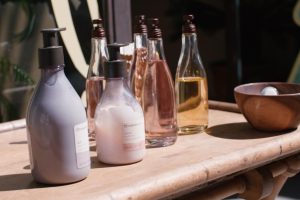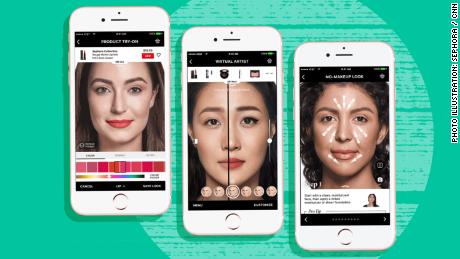Here's why the skincare industry is booming

San Francisco (CNN Business)While skincare products, such as face masks and body scrubs, play a big role in self-care routines, they’ve traditionally been more workhorses than show ponies for the beauty industry.
Recently, that’s started to change as skincare products have surged in popularity, thanks to interest in natural and organic ingredients, as well as a thriving community on social media.
Sales of skincare products in the US grew by 13% in 2018, hitting $5.6 billion, while makeup sales increased just 1%, according to data from The NPD Group, a market research company.
This is “the first time in a very long time” that the skincare industry is growing faster than the makeup industry, Stephan Kanlian, head of a think tank at New York’s Fashion Institute of Technology that studies the future of the beauty industry, told CNN Business.
Conservative estimates valued the global beauty industry at over $300 billion in 2018, according to a report from Trefis, a financial research and analysis firm. The global skincare market was valued at nearly $135 billion in 2018, increasing nearly 60% in the past 10 years. And Trefis projects it to reach $180 billion — an increase of over 30% — in the next five years.
A number of factors have contributed to the growth, according to Kanlian.
Greater scrutiny by customers of product ingredients has led to demand for natural and organic skincare brands.
New products and companies are launching at a dizzying pace, including some formed around the concept of subscription plans for facials.
Social media has opened up new avenues for purchasing and discussing skincare routines and trends.
Women, the primary consumers in the skincare industry, are adding anti-aging products to their skincare regimens as they get older. Men are increasingly showing interest in skincare products, and in turn companies are launching new lines targeted at them.
Skincare gets visual
The industry has particularly benefited from the visual nature of social platforms.
Kanlian pointed to the popularity of people posting pictures of themselves in face masks on Instagram. (Search for #facemask and over 2.4 million posts show up.) “Those are very visual,” he said. “They’re great for bloggers and vloggers to do online tutorials [and] consumers are taking photos of themselves in their favorite skincare masks.”
Summer Fridays, a brand co-founded by Instagram influencers Marianna Hewitt and Lauren Gores Ireland, launched in 2018 with just one product: a face mask. They spent no money on marketing, relying solely on their social media presences. In less than two weeks, the mask became the best-selling skin-care product on Sephora.com with thousands of positive reviews. It also repeatedly sold out online.
Hewitt and Gores, with nearly one million combined followers, spent years testing products for other companies and answering questions on social media. Over about two years, the duo developed a product using their informal focus group on social media, ultimately coming up with a clean mask packaged in a TSA-compatible size, among other attributes suggested by their followers.
“Everything we do as far as packaging, and boxes, and messaging, and photography should really be thought of on social, first and foremost,” Hewitt said.
Going natural
Social media has also given consumers a platform to promote the products they love and helped them become more informed, Kanlian said.
“I don’t think that we’ve ever seen consumers, certainly in the beauty industry, at such a high level of education and sophistication,” Kanlian said. “People are looking anywhere that they can to find a definition for natural or organic.”
That need for information is partly the result of a lack of regulation in the United States. Whereas Australia, Japan and many European countries have restricted thousands of ingredients, the US has only banned 11 chemicals from being used in beauty products. The FDA’s website says US law doesn’t give it “the authority to require cosmetic manufacturers to submit their safety data.”
While big legacy skincare brands such as Estee Lauder and L’Oreal have slowly started offering more natural alternatives, it took them a while to meet consumer demand, according to Kanlian.
That delay, along with the desire for more product information, created an opportunity for lots of smaller natural-based companies.
In 2018, natural skincare sales totaled $1.6 billion and accounted for more than a quarter of overall skincare sales — up 23% from the year before.
Nearly 50% of American women who use skincare reported that they were looking for natural or organic products, according to NPD.
Boutique brands
When Gregg Renfrew founded Beautycounter, a line of ingredient-conscious products, in 2013, she faced lots of skepticism.
“No one was talking about clean beauty,” she told CNN Business.
But in recent years, the business has “grown explosively.” Now Renfrew is committed to calling attention to the lack of regulation.
“We had to take things into our own hands,” Renfrew told CNN Business. “We’ve restricted 1,600 ingredients from our formulations” based on independent research the company has done and guidelines set by other countries.
The direct-to-consumer company relies on independent consultants, everyone from doctors to stay-at-home moms and students, to spread awareness about its products. The consultants direct shoppers to Beautycounter’s website and can earn up to 35% in commission on sales.
In 2017, Beautycounter paid over $80 million in commissions.
Beautycounter consultants share information about ingredients and also campaign for greater regulation in the industry. Beautycounter has even sent select top sellers to Washington, DC to advocate for new laws.
“We knew that we had to build a movement of consumers who were really advocating for better beauty [regulations],” Renfrew said.
Kanlian sees this need for greater transparency as the future of the skincare industry. It’s something smaller brands have realized and responded to quickly, and bigger brands are slowly starting to follow suit with new products of their own.
Source: Read Full Article


